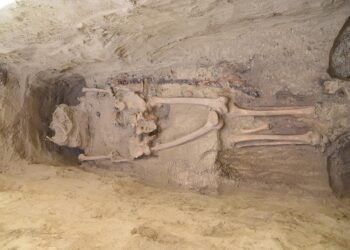A significant treasure trove of 17th-century coins was recently uncovered by a father-and-son duo, Sławomir and Szymon Milewski, in a forest near Pomiechówek, east-central Poland.
The find was made during an exploration initiated by the Polish Treasure Hunters Association “Husaria” and the Triglav Historical and Research Association, groups devoted to historical exploration and preservation. Their original objective was to trace a Roman-era trade route, but instead, they stumbled upon an extraordinary cache of coins from the 16th and 17th centuries.
Piotr Duda, an archaeologist with the Triglav Association, expressed the significance of the discovery in an interview with Polish news agency PAP, stating, “This is probably one of the largest treasures of this type ever discovered in Poland, and certainly in Mazovia.” Duda explained that while coin deposits from other eras have been uncovered in recent years, finds from this period are rare and “indescribable” in historical value. The estimated monetary value of the hoard is about 500,000 Polish złotys (around $124,000).
The discovery comprises a fascinating variety of coins from different European regions, including Saxony, Brandenburg, and the Spanish Netherlands. Notable among the hoard is a 1630 Sigismund III Vasa thaler minted at Toruń, similar to a coin sold in 2023 for over $24,500. Other coins in the collection include a 1623 John II thaler from the Duchy of Palatinate, a 1641 Frederick William I thaler from Brandenburg-Prussia, and five rare patagons from Philip IV of the Spanish Netherlands. The high quality and rarity of the coins have stunned numismatists, with some of the pieces so scarce they are barely referenced in historical catalogs.
Reflecting on how the coins ended up in this forest, Duda and other experts have several theories. One hypothesis suggests that a soldier fighting in the Thirty Years’ War or perhaps during the Swedish-Polish conflicts of the mid-1600s might have hidden his wealth for safekeeping. Pomiechówek’s proximity to Nowy Dwór Mazowiecki, the site of a 1655 battle between Swedish and Polish forces, lends weight to this theory. Another possibility, as Duda mentioned, is that a wealthy merchant buried his treasure near an inn once located in the area, intending to retrieve it later—a plan that circumstances might have prevented him from fulfilling. Duda noted that “both sides in the battle employed mercenaries, mainly Germans,” which could explain why the coins reflect a mix of origins.
Mateusz Sygacz, a member of the Husaria group and a key figure in organizing the search, described the excitement of the discovery. Sygacz recalled receiving a call as the Milewskis unearthed the first of the silver coins. Initially assuming they had found Russian kopecks, the team was astonished to recognize rare European coins. “We knew they were silver coins, and their value could be high, but when we started examining them, we were left in disbelief. It’s simply unbelievable,” he remarked.
The coins have been temporarily handed over to the Mazovian Provincial Conservator of Monuments. Although the Milewskis and the Triglav Association hope the hoard will be displayed at the Museum of the September Campaign and the Modlin Fortress, Sygacz acknowledged that the treasure’s immense value may result in its retention by the conservator for preservation.























